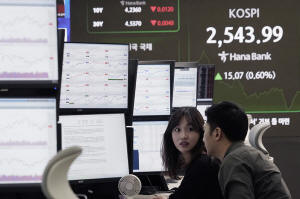World shares and US futures are higher after Wall Street losses and
Trump's speech
[March 05, 2025] By
ELAINE KURTENBACH
BANGKOK (AP) — World shares and U.S. futures were mostly higher on
Wednesday following a rocky session on Wall Street after Canada, Mexico
and China were hit by steep U.S. tariffs that took effect the day
before.
Comments by U.S. President Donald Trump in a speech to Congress and the
nation appeared to have scant impact on world markets. The future for
the S&P 500 was up 0.6%, while that for the Dow Jones Industrial Average
gained 0.5%.
Germany's DAX surged 2.4% to 22,958.74 as the prospective partners in
the country's next government said they want to loosen rules on limiting
debt to allow for higher defense spending, an issue that has gained
urgency given the wavering U.S. commitment to European allies.
The CAC 40 in Paris jumped 1.9% to 8,197.43, while Britain's FTSE 100
advanced 0.7% to 8,819.57.
China announced it intends to keep its economy growing at around a 5%
annual pace in 2025, in line with last year’s target, as it opened the
annual session of its largely ceremonial legislature. Premier Li Qiang
also promised more government spending and other measures to support
growth.
Hong Kong's Hang Seng index jumped 2.8% to 23,594.21, while the Shanghai
Composite index climbed 0.6% to 3,341.96.
Some Chinese commentators noted that Beijing had been bracing for
tariffs of up to 60%. As of Tuesday, Trump has pushed import duties on
Chinese products to 20%.

Tokyo's Nikkei 225 index edged 0.2% higher to 37,418.24. In South Korea,
the Kospi gained 1.2% to 2,558.13, while Australia's S&P/ASX 200 shed
1.2% to 8,141.10.
On Tuesday, U.S. stocks racked up more losses on Wall Street as the
trade war between the U.S. and its key trading partners escalated.
The Trump administration imposed 25% tariffs on imports from Canada and
Mexico starting Tuesday as well as doubling tariffs for Chinese exports.
All three countries have announced retaliatory actions, sparking worries
about a slowdown in the global economy.
“The global trade outlook for 2025 is marked by solid growth amid
significant challenges, many of which can be traced back to the policies
proposed by U.S. President Trump,” economists at ING said in a report.
But global trade is diverse, with the United States accounting for just
13.6% of total global exports and a similar share of global imports.
China's exports to the rest of Asia have been surging and that can help
offset reduced trade with the United States, they noted.
[to top of second column] |

Currency traders work near a screen showing the Korea Composite
Stock Price Index (KOSPI) at the foreign exchange dealing room of
the KEB Hana Bank headquarters in Seoul, South Korea, Wednesday,
March 5, 2025. (AP Photo/Ahn Young-joon)
 On Tuesday, the S&P 500 fell 1.2%,
with more than 80% of the stocks in the benchmark index closing
lower. The Dow slid 1.6% and the Nasdaq composite slipped 0.4%.
The market could soon face more twists in the tariff drama. After
Tuesday's closing bell, Commerce Secretary Howard Lutnick told Fox
Business News that the U.S. would likely meet Canada and Mexico “in
the middle" on tariffs, with an announcement coming as soon as
Wednesday.
The market rally after Trump’s election in November had been built
largely on hopes for policies that would strengthen the U.S. economy
and businesses. Worries about tariffs raising consumer prices and
reigniting inflation have been weighing on both the economy and Wall
Street.
They're also prompting warnings from retailers, given signs that
U.S. households are becoming more pessimistic about inflation and
pulling back on spending. Consumer spending has essentially driven
U.S. economic growth in the face of high interest rates.
Retaliations against the higher tariffs were swift.
China responded to new U.S. tariffs by announcing it will impose
additional tariffs of up to 15% on imports of key U.S. farm
products, including chicken, pork, soy and beef, and expanded
controls on doing business with key U.S. companies. Canada plans on
slapping tariffs on more than $100 billion of American goods over
the course of 21 days. Mexico also plans tariffs on goods imported
from the U.S.
In other dealings early Wednesday, U.S. benchmark crude oil lost 40
cents to $67.86 per barrel, while Brent crude, the international
standard, fell 12 cents to $70.92 per barrel.
The U.S. dollar fell to 149.35 Japanese yen from 149.82 yen. The
euro rose to $1.0715 from $1.0626.
Bitcoin was trading at about $88,700 according to CoinDesk.
All contents © copyright 2025 Associated Press. All rights reserved
 |